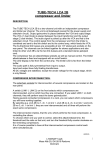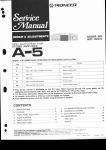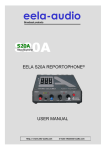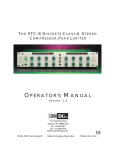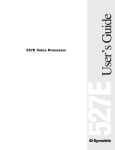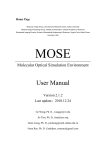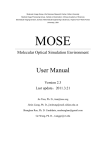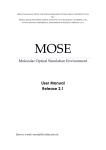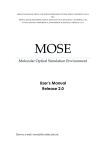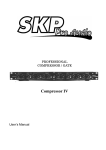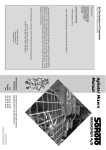Download TUBE-TECH CL 1B Compressor
Transcript
TUBE-TECH CL 1B Compressor DESCRIPTION. The TUBE-TECH compressor CL 1B differs from many other compressors, in that the gainreduction element is made from a non-semiconductor element, which in itself has a very low harmonic distortion and none of the non-linearity problems involved when using most semiconductor elements. Furthermore there is no long-term degradation of the element thus giving it almost infinite life. This element is placed after the input-transformer of the compressor and followed by an all tube-based amplifier with a gain of -dB to +30 dB. Thus the signal is not fed through any semiconductor circuitry on its way to the output. The amplifier consists of two tubes (valves) in push-pull configuration (one ECC 83 as the pre-amp and phase splitter, and one ECC 82 as the output stage), and an output transformer. The power supply for the pre-amp and phase splitter are stabilized and the heaters of both tubes (valves) are fed with a stabilized DC voltage. The whole amplifier (including input and output transformer) and the power supplies are placed on one PC-board. Both input and output are balanced (600) and fully floating. The in/out key switches the compressor in and out without clicks. THE SIDECHAIN: The side chain is the only part of the compressor that contains semiconductors. They are used for three reasons: First they do not affect the sound reproduction, second they have a high slew rate, which is of importance for the performance of the compressor and third they don't take up much room. It contains two J-FET quad op-amps, one npn-transistor and one FET-transistor, which handles the signal for the gain-reduction element. The compressor contains two time constants circuits: 1. Fixed attack and release times 2. Variable attack and release times The attack/release select switch makes it possible to use these two circuits separately or combine their functions. This gives a feature not normally obtained in other compressors: In the combined (fix. /man.) state the attack- and release controls makes it possible to obtain a complex release-time slope. (See page 4) (980112) LYDKRAFT ApS Mose Allé 20, DK 2610 Rødovre Denmark 1 COMPRESSOR INTERCONNECTION: The side chain sockets for interconnection of several compressors are located on the rear panel. A switch (BUS SELECT) on the front selects which compressors are interconnected, and on which bus they are connected. If you e.g. have 10 compressors in a rack, you can select compressor 1,5,7 and 8 on bus 1, and compressor 2,3,6 and 9 on bus 2, leaving compressor 4 and 6 in the off position. Compressors 1,5,7,8 are now interconnected and all four will perform the exact same compression. This applies to compressor 2,3,6 and 9 as well. Compressor 4 and 6 are independent. The interconnection implies, that the unit, which performs the most compression, is controlling the others. To choose which one you want to control, select the attack/release time, the threshold and the ratio on that unit, and turn the threshold fully counter clockwise on the reminding compressors. It is of course possible to have all the interconnected compressors control each other simultaneously. NB: Remember to set the ratio control and the gain control in the same position on the "slaves". Otherwise the stereo image could be shifted during compression. The attack/release-control on the slaves will have no effect. The input/output capability of the side chain-circuit allows up to ten compressors to be linked together. They are connected in parallel with a standard 1/4" stereo jack/-jack cord (tip: bus 1, ring: bus 2). The two jack socket on the rear panel is connected in parallel and both are input/output. (980112) 2 LYDKRAFT ApS Mose Allé 20, DK 2610 Rødovre Denmark CONTROLS: GAIN: The gain control is used to "make up" for the gain loss, which takes place when the unit is compressing. It is placed after the gain-reduction circuit and therefore has no influence on the threshold setting. The gain-control is continuously variable from off to +30 dB. RATIO: The ratio control varies the ratio by which the input signal is compressed. If the ratio selected is to 2:1, and the input signal increases 10 dB, the output signal is only increased by 5 db. The ratio control is continuously variable from 2:1 to 10:1. THRESHOLD: The threshold is the point where the compressor begins its action. It is defined as the point where the gain is reduced by 1 dB. The threshold is continuously variable from +20dBU to -40 dBU. METER: The VU-meter switch has three positions: 1. Input The meter is reading the level at the input socket. 2. Compression The VU-meter is reading gain reduction. Its rest position is "0 VU", and the amount of compression is shown as a decreasing deflection in dB. 3. Output NB: Leave the meter switch in position compression as it might introduce distortion if left in the input or output position. The VU-meter is reading the level at the output socket. "0 VU" is equivalent to +4 dBU. IN/OUT: This leverswitch switches the compressor in and out of the signal path. The out position bypasses the entire compressor. ATTACK: The attack control chooses how fast/slow the compressor responds to an increase in the input signal. The attack control is continuously variable from 0.5 to 300 milliseconds. RELEASE: The release control chooses how fast/slow the compressor responds to a decrease in the input signal. The release control is continuously variable from 0,05 to 10 seconds. (980112) LYDKRAFT ApS Mose Allé 20, DK 2610 Rødovre Denmark 3 ATTACK/RELEASE SELECT: This switch selects how the compressor reacts to an increase (attack) or decrease (release) of the input signal. There are three settings of the switch: 1. Fixed. Attack time: 1 msec Release time: 50 msec 2. Manual. Attack time: from 0.5 msec to 300 msec Release time: from 0.05 sec to 10 sec 3. Fix/man. This setting combines the release times of fixed and manual mode. The attack time is as in the fixed mode. The fix/man mode always has a fast attack, but it is possible to obtain a release time depending on the input signal, e.g. get a fast release when the peak disappears, then superseded shortly thereafter by the release time selected by the release control. From the time the peak disappears, until the selected release time takes over, is dependent upon the setting of the attack control. That is, the attack control changes function from a pure attack control, to a control of delay with the same time range. The more CW the attack control is turned, the longer time before the release control takes over. The more CCW the attack control is turned, the shorter time before the release control takes over. This function is valid only if the time of the peak is shorter than the setting of the attack control. If the peak of the program is longer than the setting of the attack control, or if the attack control has reached the full CCW position, it will respond as in the manual mode. The fix/man mode acts as an automatic release function with a constant fast attack time and fast release time for short peaks and a longer release times for longer peaks. This setting is mainly intended for use on program material (overall compression). BUS SELECT: Interconnects several compressors on bus 1 or bus 2. If the compressor is left in the off position, it works entirely independently. (980112) 4 LYDKRAFT ApS Mose Allé 20, DK 2610 Rødovre Denmark SUGGESTED APPLICATIONS OF TUBE-TECH COMPRESSOR CL 1B In the following, you will find suggestions on various applications of the TUBE-TECH compressor CL 1B. They are given as a convenient guide to enable you to familiarise yourself with the different aspects of using the compressor. We have not mentioned specific settings of gain and threshold as they are dependent upon input levels. Instead we have specified how much compression in dB, we feel, is needed for the various examples. OVERALL COMPRESSION: FINAL MIX COMPRESSION NEEDED: Attack/release select: Attack: Release: Ratio: 3-4 dB Fix/man 2 o'clock 10 o'clock 9 o'clock STANDARD COMPRESSION: BASS, PIANO, GUITAR, KEYBOARDS AND VOCALS COMPRESSION NEEDED: Attack/release select: Attack: Release: Ratio: 4-5 dB Manual 2 o'clock 10 o'clock 10-2 o'clock HEAVY COMPRESSION ON INSTRUMENTS: LINE GUITAR AND PIANO COMPRESSION NEEDED: Attack/release select: Attack: Release: Ratio: 10 dB Manual 7 o'clock 1 o'clock 3 o'clock COMPRESSION OF DRUMS: SNARE AND BASS DRUM COMPRESSION NEEDED: Attack/release select: Ratio: 2-3 dB Fixed 9-12 o'clock LYDKRAFT ApS Mose Allé 20, DK 2610 Rødovre Denmark (980112) 5 ADJUSTMENT PROCEDURE: CAUTION: Before making any adjustment let the unit heat-up at least 15 min. Observe that the offset-voltage measured at the side chain jack socket, when the THRESHOLD is off, is not greater than +/- 15 mV DC in both position "fixed" and "manual". (tip is bus 1 and ring is bus 2). If the voltage exceeds this value, replace either IC1 or IC2. THE GRE SHALL BE MARKED BETWEEN 1.225-1.285 ADJUSTMENT OF BASIC GAIN: 1) Apply a signal of 1 kHz, -30,0 dBU into the input of the compressor. 2) Turn the GAIN-control fully clockwise. 3) Set the RATIO-control at 2:1 4) Adjust the pre-set GAIN (located on amp/psu PCB) to an output-reading of 0,0 dBU. ADJUSTMENT OF COMPRESSION TRACKING: 1) Turn the THRESHOLD-control fully counter-clockwise. 2) Set the RATIO-control at 2:1. 3) Set the BUS-select-switch at 1. 4) Apply a signal of 1 kHz, 0,0 dBU into the input of the compressor. 5) Adjust the GAIN-control to an output-reading of 0,0 dBU. 6) Apply a DC-voltage of +250,0 mV into the side chain jack socket (tip) and observe that the output level has dropped to -10,0 dB. 7) If this is not the case, adjust the level with P 2 (P 1)*, to obtain a drop of exactly -10,0 dB. * The trimpots in parenthesis refers to PCB 870316-0,1,2 (980810) 6 LYDKRAFT ApS Mose Allé 20, DK 2610 Rødovre Denmark ADJUSTMENT OF THE VU METER READING "COMPRESSION": 1) Turn the THRESHOLD-control fully counter-clockwise. 2) Switch the METER-selector to Compression. 3) Set the RATIO-control at 2:1 4) Apply a signal of 1 kHz, 0,0 dBU into the input of the compressor. 5) Adjust the GAIN-control to an output-reading of 0,0 dBU. 6) Adjust P 4 (P 2)* until the meter is reading 0 VU. 7) Apply a DC-voltage of +250,0 mV into the side chain jack socket and observe that the output level has dropped to -10,0 dBU. If this is not the case, adjust the compression tracking (see above) 8 Adjust P 3 until the meter is reading -10,0 VU. 9) Remove the DC-voltage from the side chain jack socket. 10) Repeat step 6 - 9. NB: The VU-meter accuracy should be within +/- 0,5 dB when reading compression. ADJUSTMENT OF THE RELEASE CONTROL: 1) Set the METER switch in position compression. 2) Set the attack/release SELECT switch in position manual. 3) Apply a signal of 1 kHz, 0,0 dBU into the input of the compressor. 4) Adjust the THRESHOLD-control to a reading of -10 VU of the 5) Set the ATTACK-control at fast. 6) Set the RELEASE-control at slow. 7) Switch off the 1 kHz and observe that the VU meter moves to 0 VU in approx. 10 sec. 8) If this is not the case, adjust P 1 (P 5)*, to obtain a release time of approximately 10 sec. * The trimpots in parenthesis refers to PCB 870316-0,1,2 VU-meter (950119) LYDKRAFT ApS Mose Allé 20, DK 2610 Rødovre Denmark 7 TECHNICAL SPECIFICATIONS: Frequency-response: 5 Hz - 25 kHz +0.5/-3 dB Distortion (THD) (40 Hz - 10 kHz): 0 dBU: 10 dBU: maximum output (1 % THD): maximum input (1 % THD): Noise: Gain = 0 dB: Gain = +30 dB: Input impedance: Output impedance: < 0,15 % < 0,15 % +26,0 dBU +21,0 dBU Unweighted -85,0 dBU -75,0 dBU CCIR 468-3 -75,0 dBU -65,0 dBU 600 Ohms < 60 Ohms Compression Ratio: continuously variable from 2:1 to 10:1 Threshold: continuously variable from -40 dBU to +20 dBU Gain: continuously variable from off to +30 dB Tracking between interconnected compressors: (0 to 30 dB compression): < +/- 1 dB 8 LYDKRAFT ApS Mose Allé 20, DK 2610 Rødovre Denmark








